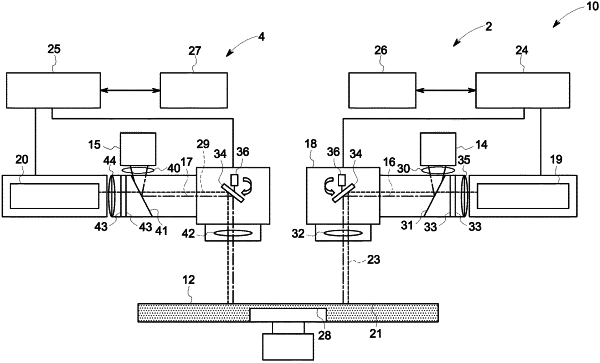| CPC B23K 26/032 (2013.01) [B22F 10/28 (2021.01); B22F 10/31 (2021.01); B22F 12/45 (2021.01); B22F 12/49 (2021.01); B22F 12/90 (2021.01); B23K 26/0608 (2013.01); B23K 26/064 (2015.10); B23K 26/082 (2015.10); B23K 26/342 (2015.10); B33Y 30/00 (2014.12); B33Y 50/00 (2014.12); B22F 10/36 (2021.01)] | 16 Claims |

|
1. An additive manufacturing system configured to manufacture a component, said additive manufacturing system comprising:
a build platform comprising a plurality of calibration marks arranged in a calibration pattern formed on a top side of the build platform;
at least two laser heads, each laser head comprising:
at least one laser device configured to generate a laser beam, wherein the laser beam is directed toward said plurality of calibration marks and said build platform, the plurality of calibration marks and the build platform each being configured to scatter the laser beam together to produce a scattering signal;
a scanning device configured to direct the laser beam toward said plurality of calibration marks and said build platform;
an optical sensor configured to detect the scattering signal of the laser beam generated by reflecting off of said plurality of calibration marks and said build platform; and
a computing device configured to:
receive the scattering signal from said optical sensor;
generate an intensity map based on the scattering signal; and
compare the intensity map based on the scattering signal to a standard map of the calibration pattern by superimposing the intensity map on the standard map; and
wherein said computing device is configured to, based on the comparison of the intensity map to the standard map, align at least one of the laser heads.
|
|
16. An additive manufacturing system configured to manufacture a component, the additive manufacturing system comprising:
a build platform comprising a plurality of calibration marks arranged in a calibration pattern;
a first laser head comprising:
a first laser device configured to generate a first laser beam, wherein the first laser beam is directed toward the plurality of calibration marks and the build platform;
a first scanning device configured to direct the first laser beam toward the plurality of calibration marks and the build platform;
a first optical sensor configured to detect a scattering signal of the first laser beam generated by reflecting off of the plurality of calibration marks and the build platform; and
a first computing device configured to receive the scattering signal of the first laser beam,
a second laser head comprising:
a second laser device configured to generate a second laser beam, wherein the second laser beam is directed toward the plurality of calibration marks and the build platform;
a second scanning device configured to direct the second laser beam toward the plurality of calibration marks and the build platform;
a second optical sensor configured to detect a scattering signal of the second laser beam generated by reflecting off of the plurality of calibration marks and the build platform; and
a second computing device configured to receive the scattering signal of the second laser beam, wherein the second computing device receives the scattering signal of the second laser beam in synchronization with the first computing device receiving the scattering signal of the first laser beam, and
wherein the first computing device is configured to generate a first intensity map corresponding to the scattering signal of the first laser beam and the position of the first laser beam,
wherein the second computing device is configured to generate a second intensity map corresponding to the scattering signal of the second laser beam and the position of the second laser beam, and
wherein the system is configured to compare the first intensity map and the second intensity map to a standard map by superimposing the first and second intensity maps on the standard map and, based on the comparisons, align the first and second laser heads.
|